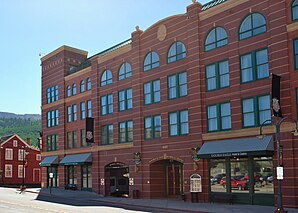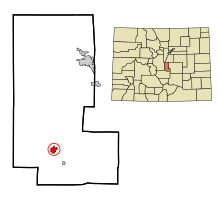Cripple Creek, Colorado
| Cripple Creek | |
|---|---|
 Downtown Cripple Creek |
|
| County and state location | |
| Basic data | |
| Foundation : | June 9, 1892 |
| State : | United States |
| State : | Colorado |
| County : | Teller County |
| Coordinates : | 38 ° 45 ′ N , 105 ° 11 ′ W |
| Time zone : | Mountain ( UTC − 7 / −6 ) |
| Residents : | 1,189 (as of 2010) |
| Population density : | 410 inhabitants per km 2 |
| Area : | 2.9 km 2 (approx. 1 mi 2 ) of which 2.9 km 2 (approx. 1 mi 2 ) are land |
| Height : | 2894 m |
| Postal code : | 80813 |
| Area code : | +1 719 |
| FIPS : | 08-18530 |
| GNIS ID : | 0204769 |
| Website : | www.cityofcripplecreek.com |
| Mayor : | Bruce Brown |
 The Double Eagle Casino in one of the historic buildings of Cripple Creek |
|
Cripple Creek is a small town in the US state of Colorado . The Statutory City is the county seat of Teller County . It is located 70 km southwest of Colorado Springs on the southern foothills of Pikes Peaks and has been one of Colorado's most famous gamblers' paradises since gambling was legalized in 1991. The Cripple Creek Historic District has been a National Historic Landmark since 1961 and covers most of the urban area.
history
Cripple Creek was one of the most famous gold rush towns in Colorado during the gold rush . In the Tertiary , the area around Cripple Creek was volcanically very active. It belongs to the Thirtynine Mile Volcanic Field in Colorado. These activities brought large amounts of gold close to the surface of the earth. There are also sulphides and tellurium compounds that give the county its name.
With an altitude of 2896 m and located just below the tree line, the high valley around Cripple Creek was long considered only as grazing area for cattle. Many land exploiters avoided the area after the misnamed Mount Pisgah Hoax sparked a mini gold rush. This was triggered by the simple trick that worthless rock was mixed with gold.
Rich gold ore was found in 1891, which triggered the last great gold rush in Colorado. Thousands of gold diggers rushed into the region, and it wasn't long before WS Stratton discovered the then famous Independence gold vein , making one of the greatest gold discoveries in history. In 1900, Cripple Creek and its sister city, Victor, were wealthy settlements.
In the 1890s, many of the miners in the Cripple Creek area joined a miners' union, the Western Federation of Miners (WFM). The Cripple Creek miners' strike of 1894 was one of the few occasions in Colorado history when an incumbent governor deployed the Colorado National Guard to protect the miners from being attacked by forces controlled by the mine owners. By 1903 the state government was turned and Governor James Peabody sent the National Guard to Cripple Creek on November 23, 1903 to crush the power of the miners' union in the gold digging camps. This 1903 strike and the governor's reaction preceded the Colorado Labor Wars , which claimed many lives.
On July 4, 1961, much of Cripple Creek was granted National Historic Landmark status as a Historic District . On October 15, 1966, the Cripple Creek Historic District was added to the National Register of Historic Places .
By 2005, approximately 23.5 million troy ounces (731 tons) of gold had been produced in and around Cripple Creek . When the mines became less productive, most of the population left the region. Cripple Creek became a ghost town and, as such, a tourist attraction. The old underground mines are exhausted, but an open-cast mine has been in operation east of the city near Victor since 1994.
Towards the end of the 20th century, the city received approval to offer games of chance . These casinos are housed in many of the historic buildings. This led to a revival and regular income.
The Cripple Creek and Victor Narrow Gauge Railroad is a narrow-gauge museum railroad with four steam locomotives. In 2006/2007 a large historical museum was built in Cripple Creek, the Pikes Peak Heritage Center .
geography
Cripple Creek geographical coordinates are 38 ° 45 ' N , 105 ° 11' W .
According to the United States Census Bureau , the city has an area of 2.9 km² , which consists entirely of land.
Demographics
At the time of the United States Census 2000, Cripple Creek was inhabited by 1,115 people. The population density was 381.0 people per km ². There were 737 housing units at an average of 251.8 per km ². The Cripple Creeks population was 92.29% White , 0.90% Black or African American , 2.15% Native American , 0.81% Asian , 1.43% said they were racial , and 2.42% named two or more races. 6.01% of the population declared to be Hispanic or Latinos of any race.
The residents of Cripple Creeks were distributed to 494 households out of which 23.3% were living in children under the age of 18. 44.7% of households were married, 7.9% had a female head of the household without a husband and 42.9% were not families. 30.4% of households were made up of individuals and someone lived in 4.9% of all households aged 65 years or older. The average household size was 2.26 and the average family size was 2.82 people.
The urban population was divided into 22.2% minors, 10.4% 18–24 year olds, 29.2% 25–44 year olds, 30.2% 45–64 year olds and 8.0% aged 65 and over or more. The median age was 39 years. For every 100 women there were 104.2 men. For every 100 women over 18, there were 100.0 men.
The median household income in Cripple Creek was 39,261 US dollars and the median family income reached the amount of 41,685 US dollars. The median income for men was $ 27,600, compared with $ 25,000 for women. The per capita income for Cripple Creek was $ 19,607. 6.4% of the population and 4.7% of families had an income below the poverty line , including 3.8% of minors and 6.1% of those aged 65 and over.
Mention of the place in popular culture
One of the most played classic bluegrass - Instrumental -pieces for banjo and guitar called Cripple Creek . It has been performed by many famous musicians, including Hank Snow and Chet Atkins . Neil Young's album After the Gold Rush from the year 1970 contains the song Cripple Creek Ferry . The Band released an album in 1969 with the song Up on Cripple Creek ; however, this refers to Lake Charles in Louisiana . The Cripple Creek Theater Company in New Orleans got its name from this title. Craig T. Nelson began his acting career at the Imperial Hotel in Cripple Creek.
Robert Bly's poem Condition of the Working Classes, from his 1973 book Sleepers Joining Hands, is about Cripple Creek. His already in 1967 published the poem "After the Industrial Revolution, All Things Happen at Once" from the National Book Award -winning collection The Light Around the Body cited "the dead of Cripple Creek" Linda Goodman's novel Gooberz (1989) plays in Cripple Creek , their place of residence. Vincent J. Cardinal Off-Broadway -Stück The Colorado Catechism (1990) set in a fictional rehabilitation center in Cripple Creek.
In Bob Dylan's 1962 song Rambling, Gambling Willie , the location is mentioned in the fourth verse. The song was only released in 1991 on the album The Bootleg Series Volumes 1–3 (Rare & Unreleased) 1961–1991. In Stephen Baxter's novel The Last Flood , Cripple Creek is the last city to house and operate the US government before the continent is flooded.
sons and daughters of the town
- Bill Butler (* 1921), cameraman
- Robert Tannenbaum (1915–2003), organizational and leadership theorist
supporting documents
- ↑ Dan Plazak: A Hole in the Ground with a liar at the Top (2006) ISBN 978-0-87480-840-7
- ↑ Listing of National Historic Landmarks by State: Colorado . National Park Service , accessed July 29, 2017.
- ^ Cripple Creek Historic District on the National Register Information System. National Park Service , accessed July 29, 2017.
Web links
- City of Cripple Creek
- Cripple Creek CDOT map (PDF; 231 kB)
- Visit Cripple Creek: The Official Website for Travel to Cripple Creek, Colorado
- Cripple Creek Photos and Information.
